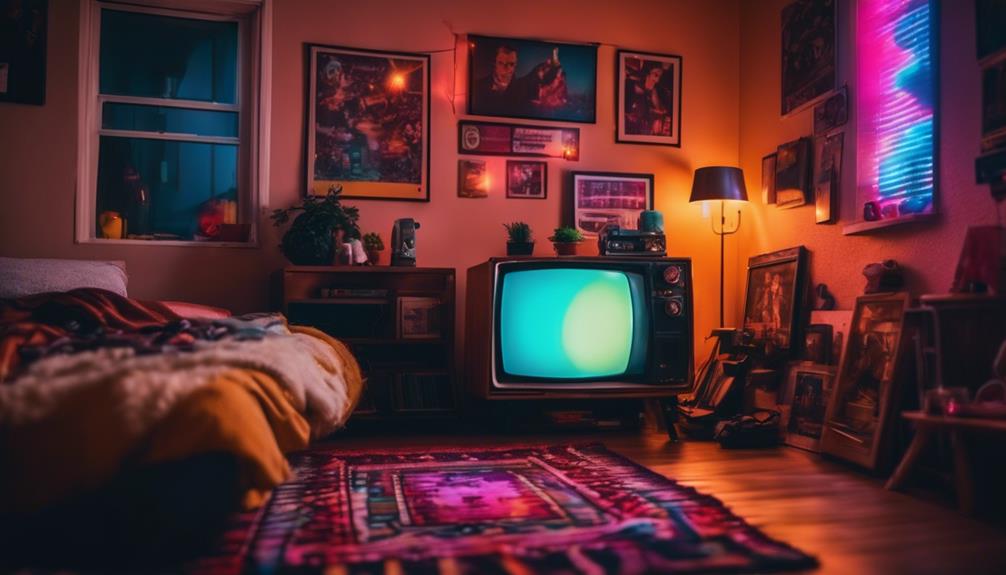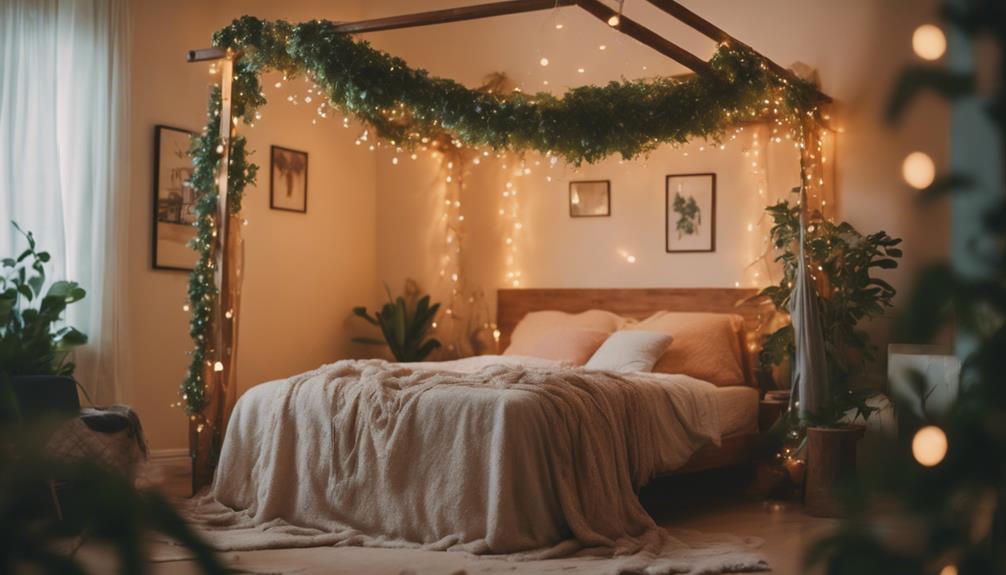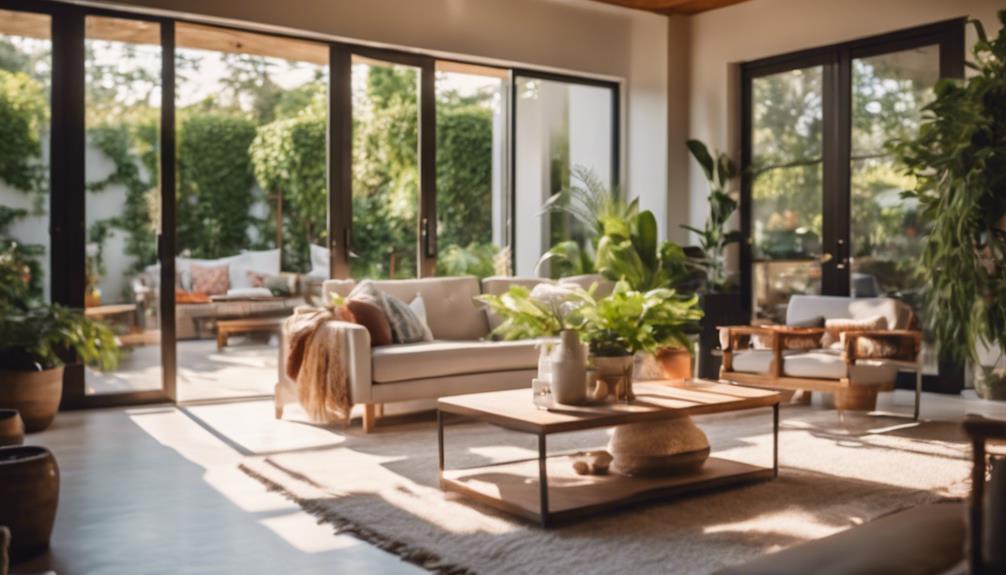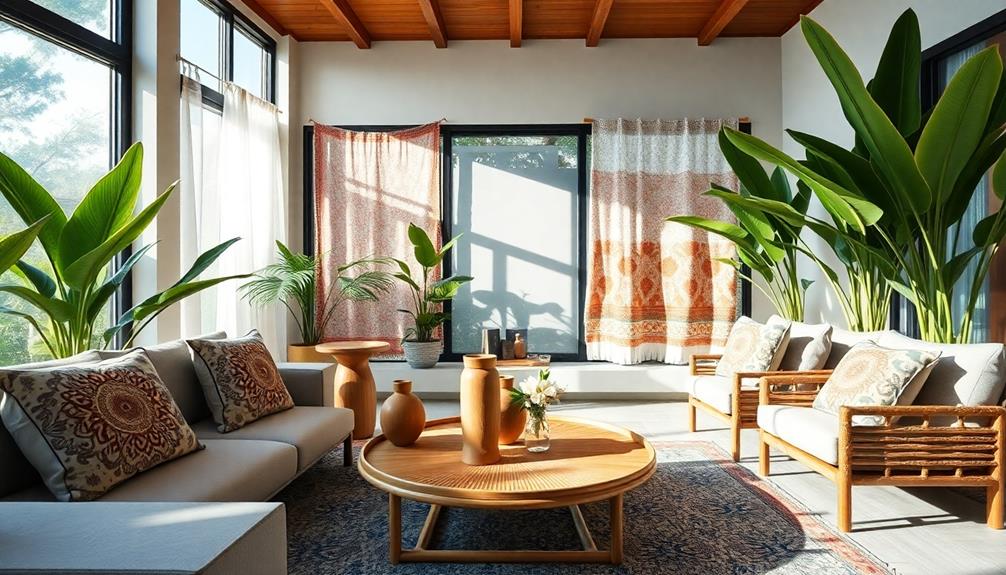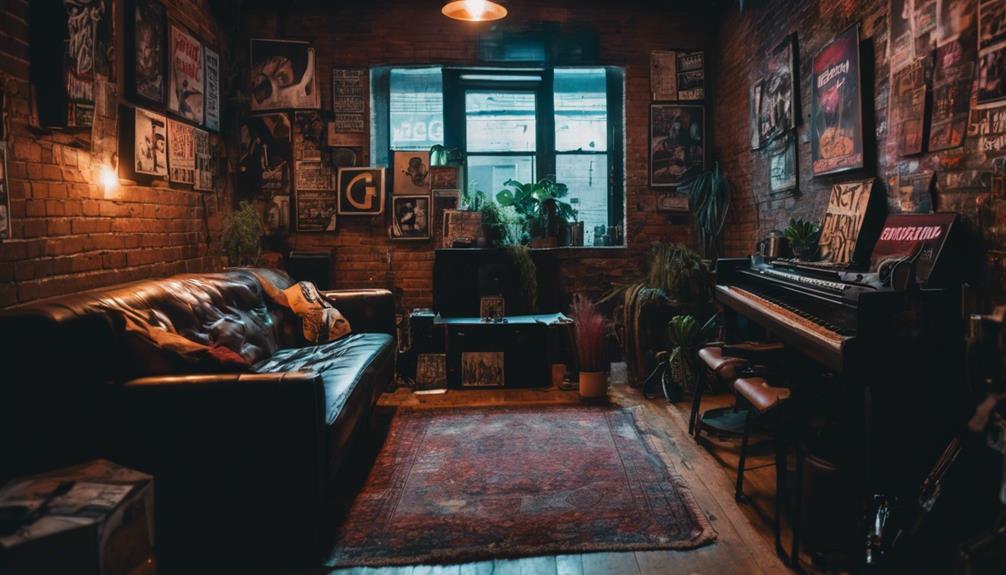To create a Stranger Things-inspired room, start with a moody color palette featuring maroon, navy, and burnt orange. Incorporate cozy wood paneling and layer in textured rugs to enhance warmth. Vintage decor like leather sofas and classic arcade game cabinets will add charm and nostalgia. Don't forget about lighting—string lights and lava lamps can create that perfect eerie atmosphere. For finishing touches, display items like a Hawkins High banner or Dungeons & Dragons sets. This setup captures the 1980s essence brilliantly, and there's plenty more inspiration waiting to help you perfect your design.
Key Elements
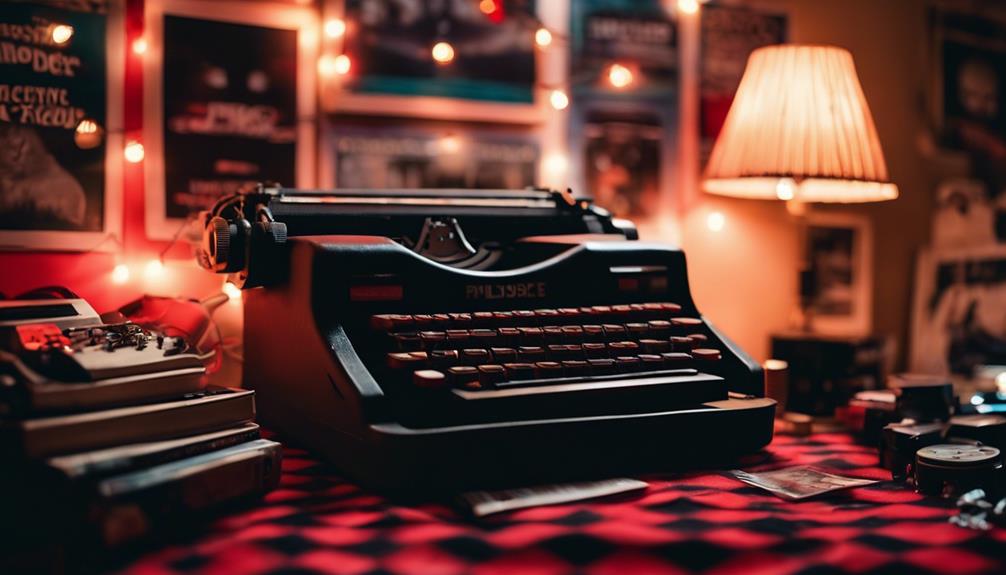
When you're creating a Stranger Things-inspired space, the color scheme plays an essential role in setting the mood.
You'll want to incorporate materials and textures that evoke that nostalgic 80s vibe, like wood paneling and thick carpets.
Color Scheme
The color scheme of Stranger Things embraces moody yet vibrant hues, including maroon red, navy blue, dark teal, mustard yellow, and burnt orange, to capture the essence of the 1980s. When you're designing your own aesthetic room, consider this nostalgic color palette to evoke that retro vibe. These colors are less saturated, mimicking the printing capabilities of the mid-1980s and enhancing the overall nostalgic atmosphere.
Contrast plays a crucial role in the design, so don't shy away from pairing colors from opposite sides of the color wheel. This creates depth and adds mood to your room decor. You can balance the sinister elements of the show with warmth by integrating groovy patterns and subdued fluorescent lighting throughout your space.
While bright colors typically don't fit into the Stranger Things aesthetic, you can find ways to incorporate these dynamic shades in a way that feels cohesive. By sticking to this specific color palette, you'll create a room that resonates with the iconic style of the series while maintaining that intimate, vintage feel.
Materials
To create a Stranger Things-inspired room, focus on incorporating materials that reflect the 1980s aesthetic, like wood panels and thick carpets, which establish a vintage atmosphere.
Start with wood paneling for your walls—it evokes the cozy, nostalgic feel of the era. Layer plush, thick carpets to soften the space and add warmth.
For your furniture, mix and match essentials that embody 80s decor, such as leather sofas and low wooden coffee tables. Incorporate vintage items like CRT TVs or retro gaming consoles to enhance the nostalgic vibe.
Don't forget about the lighting! Use dim lighting to create an eerie ambiance reminiscent of the show. String lights, lava lamps, and even repurposed Christmas lights can help set the mood beautifully.
For wall decor, consider adding alphabet decals or band posters that reflect popular culture from the 80s. Floral or plaid wallpaper can also add character to your space.
Textures
Embrace a variety of textures to transform your space into a cozy, nostalgic haven reminiscent of the 1980s vibe in Stranger Things.
Start by incorporating thick carpets and textured rugs that not only add warmth but also evoke the comfort found in Hawkins homes. Wood paneling can serve as a primary wall texture, capturing that vintage feel essential to the show's aesthetic.
To enhance the eclectic 80s vibe, layer patterned tapestries or throw blankets featuring floral or plaid designs throughout your room. These elements provide additional comfort while contributing to the overall texture.
Don't forget to utilize string lights and fairy lights, which act as both decorative and textural elements, casting a soft glow that immerses you in the atmosphere typical of the series.
Lastly, consider retro furniture pieces like leather sofas and low wooden coffee tables. They juxtapose different textures, creating a layered, inviting environment that draws you in.
Essential Fixtures and Furniture
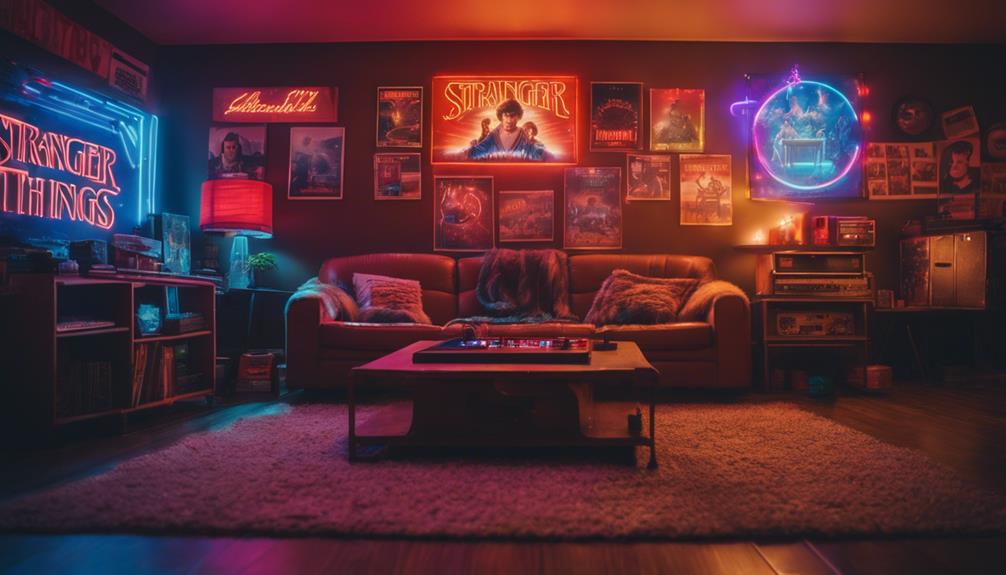
To truly capture the essence of the Stranger Things vibe, you'll want to incorporate essential fixtures and furniture that reflect the era.
Think about adding a vintage arcade game cabinet, retro bean bag chairs, and a vintage record player stand to create a fun and immersive atmosphere.
These pieces not only enhance the room's aesthetic but also invite you to relax and enjoy the nostalgic charm.
Vintage Arcade Game Cabinet
A vintage arcade game cabinet is a must-have fixture that instantly transports your room into the nostalgic domain of the 80s, featuring classic games like Pac-Man and Donkey Kong. This retro design not only captures the essence of the era but also aligns perfectly with the Stranger Things aesthetic, making it a standout piece in your decor.
Choosing the right vintage arcade cabinet can add a unique flair to your space. Look for cabinets with bright graphics and wood finishes to enhance that retro vibe. You can even restore or refurbish a cabinet to customize its color and gameplay, giving it a personal touch that reflects your style.
Incorporating a vintage arcade game cabinet doesn't just enhance your room's ambiance; it also provides a fun activity for you and your friends. It encourages social interaction and engagement with the retro theme, making it a conversation starter.
To find an authentic vintage arcade cabinet, check out local thrift stores, flea markets, or online marketplaces. You might discover unique pieces that fit your aesthetic vision and complete your Stranger Things-inspired room.
Retro Bean Bag Chairs
Retro bean bag chairs bring a playful and cozy element to your Stranger Things-themed room, perfectly echoing the vibrant and relaxed atmosphere of the 1980s.
These chairs, characterized by their soft, squishy design and colorful fabric, are essential fixtures that enhance the nostalgic vibe of your space. With vibrant colors like burnt orange, dark teal, and mustard yellow, they align beautifully with the show's moody yet vibrant color palette.
One of the best features of bean bag chairs is their versatility. You can easily move them around, making it simple to create a cozy hangout space for friends or family.
To add a unique flair, consider incorporating patterned fabrics or prints that mirror the quirky aesthetic seen in the series. This won't only make the chairs stand out but also contribute to the overall theme.
To achieve an authentic retro feel, look for vintage-style bean bag chairs that evoke the playful spirit of the mid-1980s.
Whether you're relaxing while binge-watching your favorite episodes or hosting a game night, these retro bean bag chairs will make your space feel inviting and nostalgic.
Vintage Record Player Stand
Why not elevate your Stranger Things-themed room with a vintage record player stand that not only showcases your vinyl collection but also enhances the nostalgic ambiance?
A well-crafted vintage record player stand typically features wooden construction with a retro finish in dark hues like mahogany or walnut, perfectly aligning with the 1980s aesthetic.
Look for stands designed to hold 50-100 albums, providing ample storage and easy access to your favorite records. Many options come with integrated speakers or space for a sound system, ensuring your audio experience resonates with the show's vibe.
To further capture that retro feel, opt for designs incorporating checkered patterns or geometric shapes. This will maintain a cohesive look throughout your room.
Don't forget to accessorize! Adding decorative elements like vintage album covers or retro memorabilia around the stand will complete the scene and transport you back to the 1980s.
Incorporate a vintage record player stand into your decor, and watch as it transforms your space into a nostalgic haven that perfectly reflects the essence of Stranger Things.
Lighting Ideas
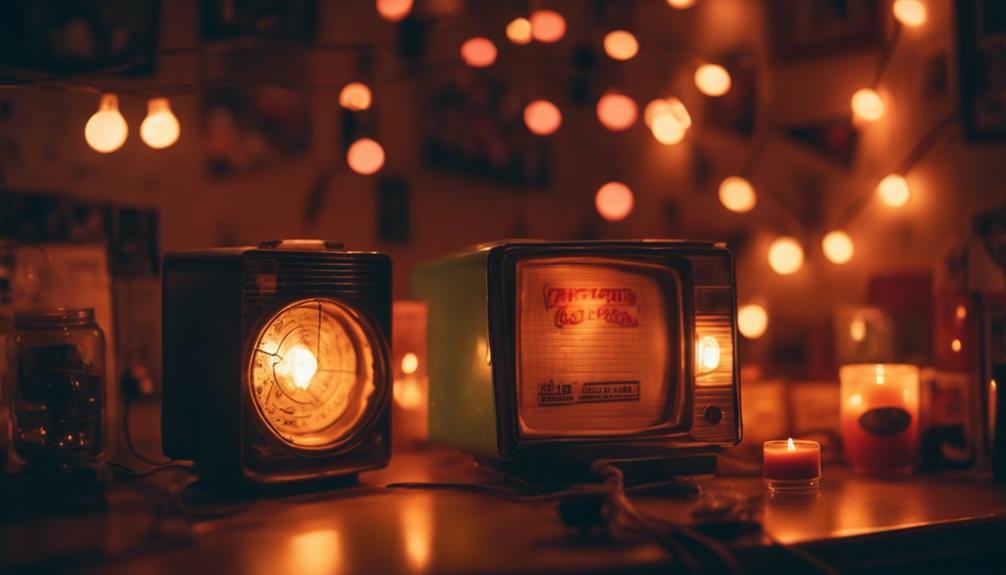
When it comes to lighting your Stranger Things-themed room, you'll want to create an atmosphere that feels both nostalgic and a bit spooky.
Consider adding a neon Stranger Things sign, layering eerie string lights, and incorporating dimmer switches for that perfect mood.
Flickering candlelight can enhance the ambiance, making your space feel like it's straight out of Hawkins.
Neon Stranger Things Sign
Brighten up your space with a neon sign inspired by Stranger Things, showcasing iconic quotes or symbols that capture the show's eerie charm. A neon sign can transform your room into a nostalgic haven, reflecting the unique essence of the series.
Consider using LED neon flex lights for a modern twist; these are safer and more energy-efficient than traditional glass options, allowing for versatile shapes and designs.
To enhance the retro vibe, select a color palette that aligns with the show's aesthetic. Moody yet vibrant hues like dark teal, maroon red, or burnt orange will help evoke that 1980s feel.
Position your neon sign in a prominent area, such as above your desk or bed, to create a striking focal point that draws the eye and sets the mood.
For a personal touch, opt for customizable neon signs. Choose phrases or designs that resonate with your fandom while maintaining the show's nostalgic feel. This way, you can create a unique atmosphere that celebrates your love for Stranger Things and makes your space truly your own.
Eerie String Lights Arrangement
Transform your space with an eerie string lights arrangement that captures the nostalgic essence of the 1980s, just like in Stranger Things. Start by selecting LED or fairy lights to create a warm, inviting atmosphere in your room. Drape them along plain white walls or around windows to add depth and character. You can even repurpose old Christmas lights for that retro feel—perfect for evoking the show's aesthetic.
To make your room truly stand out, use colored bulbs in shades of blue, yellow, green, and red. These colors reflect the moody yet vibrant palette of the series and will welcome back memories of Hawkins, Indiana. Consider creating focal points by weaving the lights over furniture or into other decorative elements, like a vintage lamp or a lava lamp, for that cozy, eerie vibe.
The right arrangement of string lights can transform your space into a nostalgic wonderland that's both eerie and inviting, perfect for any Stranger Things enthusiast. So, turn off the overhead lights and let your eerie string lights shine!
Flickering Candlelight Effect
Create a cozy atmosphere with a flickering candlelight effect that captures the charm and nostalgia of Stranger Things. To achieve this, consider using LED candles that mimic the soft glow and randomness of real flames. They provide a safe, atmospheric lighting option that won't compromise your decor.
Pair these LED candles with charming string lights to enhance the retro vibe. This combination creates a warm and inviting ambiance reminiscent of the 1980s while avoiding the harshness of overhead lighting. You might also incorporate vintage-style lanterns or hurricane lamps, as their glass shades beautifully diffuse light, adding to the nostalgic feel.
For additional versatility, utilize dimmable smart bulbs in your table lamps. Adjusting brightness levels and color temperatures can help simulate candlelight, allowing you to customize the room's mood.
To tie it all together, place your candles on rustic wooden surfaces or within vintage holders. Natural materials enrich the warm, vintage aesthetic typical of the Stranger Things setting.
With these lighting ideas, you'll create a mesmerizing environment that feels both cozy and reminiscent of your favorite show.
Dimmer Switch for Atmosphere
A dimmer switch can instantly enhance the atmosphere of your room, allowing you to adjust the lighting to match the mood of your Stranger Things-inspired decor. By controlling the brightness, you can create an eerie and immersive ambiance reminiscent of the show's suspenseful scenes.
If you're using string lights or LED fairy lights, installing a dimmer switch enhances that retro vibe. You can easily shift from bright, cheerful lighting during social gatherings to a moody glow for intimate movie nights. Make sure to choose dimmer switches compatible with LED lights to effectively manage energy consumption while keeping that vintage feel intact.
Incorporating a dimmer switch not only helps recreate the nostalgic ambiance of the 1980s but also allows your themed decor elements to shine. Bright lighting can make your decor pop, while dimmer settings add depth and intrigue.
Decorative Elements
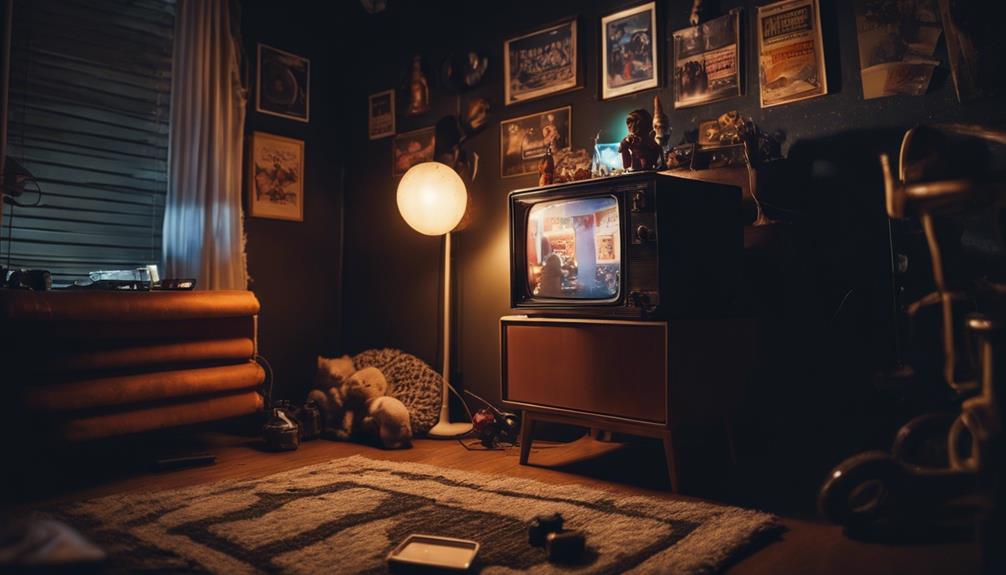
To truly capture the spirit of Stranger Things, you'll want to incorporate key decorative elements like a vintage Hawkins High School banner and some eye-catching Upside Down wall art.
Adding a classic Dungeons & Dragons set not only pays homage to the show but also brings a fun, interactive touch to your space.
Together, these pieces create an engaging atmosphere that fans will appreciate.
Vintage Hawkins High School Banner
Transform your space with a vintage Hawkins High School banner that captures the nostalgic essence of the show. You can create this banner using fabric or canvas, featuring the school's logo and colors. Incorporating elements like the school's mascot and the year it was established adds an authentic touch that connects your decor to the series.
To achieve that retro look, opt for faded colors like maroon and navy, reflecting the show's aesthetic and the vibes of the 1980s. When displaying the banner, consider hanging it with clips or string lights to create a dynamic and engaging focal point. The banner will evoke a sense of community, reminiscent of the characters' shared experiences in Hawkins.
Incorporating this vintage banner into your decor allows it to blend seamlessly with other 80s-inspired elements, such as band posters and vintage furniture. It not only enhances the overall atmosphere of your space but also sparks conversations about your favorite moments from the show.
Upside Down Wall Art
Building on the nostalgic vibe of the vintage Hawkins High School banner, Upside Down wall art adds a thrilling and eerie element to your decor that captures the unsettling essence of the show. You can create this enchanting art by using dark, moody colors like navy blue, maroon red, and dark teal. These shades evoke the parallel dimension of the Upside Down, setting the perfect tone for your space.
To add depth and texture, consider utilizing mixed media techniques. Layer materials such as wood, fabric, and painted canvases, mimicking the show's unsettling environment. Incorporating iconic symbols from Stranger Things, like the Demogorgon or the Mind Flayer, will heighten the themes of danger and adventure.
For an extra touch, use string lights or LED fairy lights to illuminate your wall art. This creates a haunting glow that mirrors the atmospheric vibe of the series.
Classic Dungeons & Dragons Set
Classic Dungeons & Dragons elements can instantly transport you to the imaginative territories of the 1980s, enhancing your decor with a sense of adventure and nostalgia.
Start by displaying vintage rulebooks and game manuals on a low wooden coffee table. This simple touch evokes the tabletop gaming culture that defined an era.
Next, incorporate decorative dice sets—those colorful polyhedral dice can add playful accents to your space. Consider placing them in a glass container or showcasing them on a shelf.
To deepen the theme, frame and hang artwork or posters featuring iconic Dungeons & Dragons imagery, like dragons or enchanting landscapes.
For a DIY flair, craft a large wall mural depicting a classic campaign setting, such as a mythical forest or a dungeon, to serve as a stunning focal point in your room.
Finally, don't forget the lighting! Integrate themed lighting, like LED strips or fairy lights, around your gaming area. This creates an atmospheric glow reminiscent of the magical territories you explore in your Dungeons & Dragons adventures.
Together, these elements create a mesmerizing decor that brings the spirit of the game to life.
Flooring
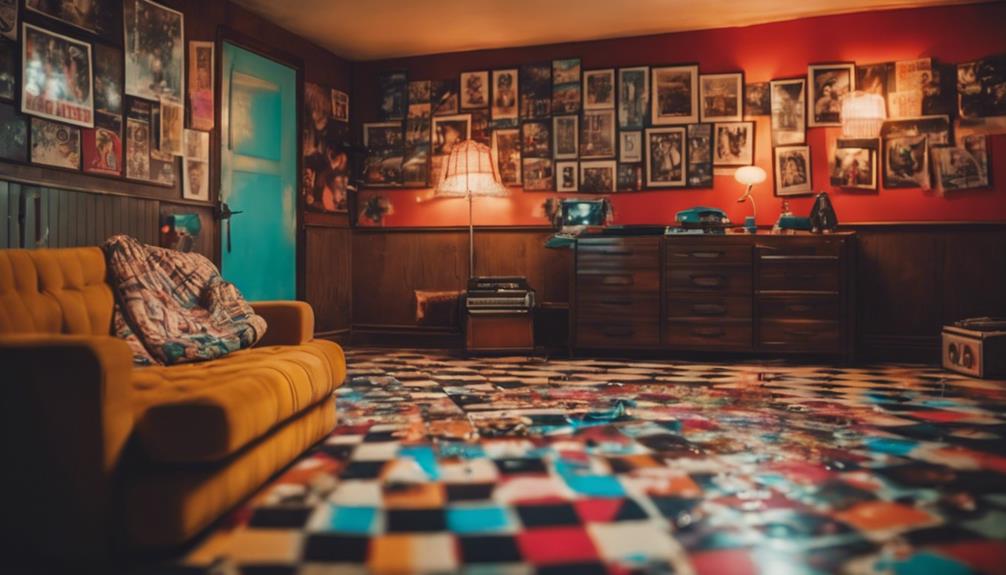
When choosing flooring for your Stranger Things room, think about incorporating checkered black and white tiles for that retro vibe.
Rustic wooden plank flooring can add warmth and character, while a faded red carpet runner brings in a touch of nostalgia.
Each option helps create an immersive atmosphere that captures the essence of the 1980s.
Checkered Black and White Tiles
Checkered black and white tiles instantly bring a retro 1980s vibe to your Stranger Things-inspired room, creating a bold and nostalgic atmosphere. This classic design element not only adds visual contrast but also enhances the nostalgic feel reminiscent of diners and vintage homes from that era.
When you incorporate these tiles, you'll find they complement other decor elements beautifully, such as wood paneling and vintage furniture, helping you achieve a cohesive retro aesthetic. The checkerboard pattern serves as an eye-catching backdrop, making your themed decor items stand out, further enhancing the room's ambiance.
One of the best parts about checkered tiles is how easy they're to clean and maintain. You won't have to worry about extensive upkeep, allowing you to focus on enjoying your space. Plus, they're durable, promising longevity while contributing to your room's overall charm.
Incorporating checkered black and white tiles can transform your Stranger Things room into an enthralling homage to the 1980s. So go ahead, lay down those tiles, and watch your space come alive with the spirit of that unforgettable decade.
Rustic Wooden Plank Flooring
Rustic wooden plank flooring instantly evokes a warm, vintage feel that perfectly captures the essence of the 1980s in your Stranger Things-themed room.
This flooring style features wide planks and a distressed finish, creating a nostalgic atmosphere that aligns beautifully with the show's aesthetics. The color palette typically includes deep browns, rich mahogany, and weathered gray tones, enhancing the moody yet vibrant vibe found in the series.
Incorporating rustic wooden floors can greatly elevate your room's design, providing a natural, organic texture that contrasts with more modern elements. Not only does it add character, but it also instills a sense of comfort and familiarity synonymous with the era.
To maintain the beauty of your rustic flooring, regular care is essential. You'll need to sweep frequently and consider re-oiling or refinishing it occasionally to preserve its integrity.
To further enhance the 1980s vibe, consider layering area rugs with retro patterns on your wooden floors. This not only adds visual interest but also brings an inviting warmth, making your Stranger Things room feel like a true homage to the beloved series.
Faded Red Carpet Runner
To enhance the nostalgic vibe created by the rustic wooden flooring, a faded red carpet runner brings a vintage aesthetic that perfectly complements your Stranger Things-themed room. This type of flooring can evoke the 1980s interiors, adding to the overall ambiance you're aiming for.
Opt for a low-pile or shag style to enhance the retro feel, making it comfortable for lounging while still maintaining an authentic look. Consider incorporating checkered patterns or subtle floral designs into your runner. These details help to capture the eclectic mix of decor typical of the era.
Durability is key, so choose a runner that's easy to clean, as it'll likely experience heavy foot traffic, especially in a fun, themed space like yours.
To create a cohesive and inviting atmosphere, pair the carpet runner with warm, moody colors from the Stranger Things palette, such as maroon or burnt orange. These colors not only enhance the vintage vibe but also tie the whole room together.
With the right faded red carpet runner, your room will transport you back to the thrilling adventures of Hawkins, Indiana.
How Can I Incorporate Stranger Things Room Decor into the Latest Aesthetic Trends?
Incorporating Stranger Things room decor into the latest trendy aesthetic room decor trends is a great way to add a nostalgic and unique touch to your space. Consider adding vintage posters, retro furniture, and iconic memorabilia from the show to create a trendy and immersive atmosphere in your room.
Conclusion
By incorporating these key elements into your Stranger Things room decor, you can create a space that truly captures the show's nostalgic vibe.
Focus on essential fixtures and furniture, explore creative lighting ideas, and add decorative elements that reflect the eerie charm of Hawkins.
Don't forget to reflect on your flooring choices to complete the look.
With these tips, you're ready to transform your room into a tribute to the beloved series that'll impress any fan!
